好富顿难燃液压油HF-322C MSDS
- 格式:pdf
- 大小:210.27 KB
- 文档页数:8
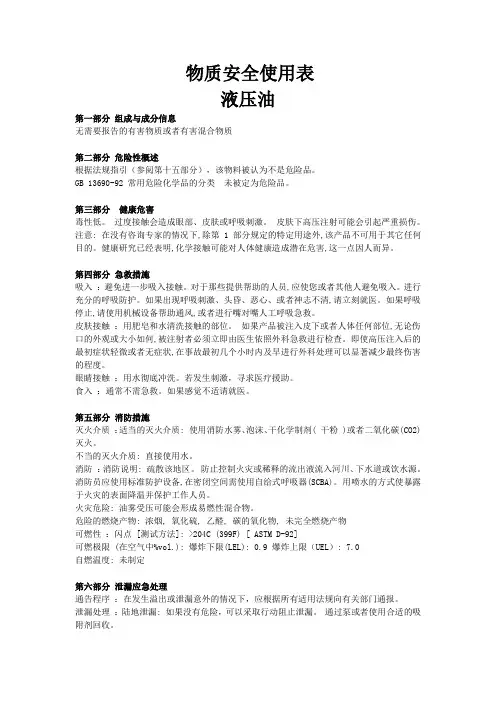
物质安全使用表液压油第一部分组成与成分信息无需要报告的有害物质或者有害混合物质第二部分危险性概述根据法规指引(参阅第十五部分),该物料被认为不是危险品。
GB 13690-92 常用危险化学品的分类未被定为危险品。
第三部分健康危害毒性低。
过度接触会造成眼部、皮肤或呼吸刺激。
皮肤下高压注射可能会引起严重损伤。
注意: 在没有咨询专家的情况下,除第1部分规定的特定用途外,该产品不可用于其它任何目的。
健康研究已经表明,化学接触可能对人体健康造成潜在危害,这一点因人而异。
第四部分急救措施吸入:避免进一步吸入接触。
对于那些提供帮助的人员,应使您或者其他人避免吸入。
进行充分的呼吸防护。
如果出现呼吸刺激、头昏、恶心、或者神志不清,请立刻就医。
如果呼吸停止,请使用机械设备帮助通风,或者进行嘴对嘴人工呼吸急救。
皮肤接触:用肥皂和水清洗接触的部位。
如果产品被注入皮下或者人体任何部位,无论伤口的外观或大小如何,被注射者必须立即由医生依照外科急救进行检查。
即使高压注入后的最初症状轻微或者无症状,在事故最初几个小时内及早进行外科处理可以显著减少最终伤害的程度。
眼睛接触:用水彻底冲洗。
若发生刺激,寻求医疗援助。
食入:通常不需急救。
如果感觉不适请就医。
第五部分消防措施灭火介质:适当的灭火介质: 使用消防水雾、泡沫、干化学制剂( 干粉 )或者二氧化碳(CO2)灭火。
不当的灭火介质: 直接使用水。
消防:消防说明: 疏散该地区。
防止控制火灾或稀释的流出液流入河川、下水道或饮水源。
消防员应使用标准防护设备,在密闭空间需使用自给式呼吸器(SCBA)。
用喷水的方式使暴露于火灾的表面降温并保护工作人员。
火灾危险: 油雾受压可能会形成易燃性混合物。
危险的燃烧产物: 浓烟, 氧化硫, 乙醛, 碳的氧化物, 未完全燃烧产物可燃性:闪点 [测试方法]: >204C (399F) [ ASTM D-92]可燃极限 (在空气中%vol.): 爆炸下限(LEL): 0.9 爆炸上限(UEL): 7.0 自燃温度: 未制定第六部分泄漏应急处理通告程序:在发生溢出或泄漏意外的情况下,应根据所有适用法规向有关部门通报。

HYDROFLUORIC ACID1. Product IdentificationSynonyms: Fluorohydric acid; fluoric acid; Hydrogen fluoridesolutionCAS No.: 7664-39-3Molecular Weight: 20.01Chemical Formula: HF in Aqueous Solution.Product Codes:2. Composition/Information on IngredientsIngredient CAS No Percent Hazardous--------------------------------------- ------------ ------------ ---------Hydrogen Fluoride 7664-39-3 49 - 50% YesWater 7732-18-5 49 - 50% No3. Hazards IdentificationEmergency Overview--------------------------POISON! DANGER! CORROSIVE. EXTREMELYHAZARDOUS LIQUID AND VAPOR. CAUSES SEVEREBURNS WHICH MAY NOT BE IMMEDIATELY PAINFUL ORVISIBLE. MAY BE FATAL IF SWALLOWED OR INHALED.LIQUID AND VAPOR CAN BURN SKIN, EYES ANDRESPIRATORY TRACT. CAUSES BONE DAMAGE.REACTION WITH CERTAIN METALS GENERATESFLAMMABLE AND POTENTIALLY EXPLOSIVEHYDROGEN GAS.-----------------------------------------------------------------------------------------------------------Health Rating: 4 - Extreme (Poison)Flammability Rating: 0 - NoneReactivity Rating: 2 - ModerateContact Rating: 4 - Extreme (Corrosive)Lab Protective Equip: GOGGLES & SHIELD; LAB COAT &APRON; VENT HOOD; PROPER GLOVESStorage Color Code: White (Corrosive)-----------------------------------------------------------------------------------------------------------Potential Health Effects----------------------------------Exposure to hydrofluoric acid can produce harmful health effects thatmay not be immediately apparent.Inhalation:Severely corrosive to the respiratory tract. May cause sore throat,coughing, labored breathing and lung congestion/inflammation.Ingestion:Corrosive. May cause sore throat, abdominal pain, diarrhea, vomiting,severe burns of the digestive tract, and kidney dysfunction.Skin Contact:Corrosive to the skin. Skin contact causes serious skin burns whichmay not be immediately apparent or painful. Symptoms may bedelayed 8 hours or longer. The fluoride ion readily penetrates the skincausing destruction of deep tissue layers and even bone.Eye Contact:Corrosive to the eyes. Symptoms of redness, pain, blurred vision, andpermanent eye damage may occur.Chronic Exposure:Intake of more than 6 mg of fluorine per day may result in fluorosis,bone and joint damage. Hypocalcemia and hypomagnesemia can occur from absorption of fluoride ion into blood stream.Aggravation of Pre-existing Conditions:Persons with pre-existing skin disorders, eye problems, or impairedkidney or respiratory function may be more susceptible to the effectsof this substance.4. First Aid MeasuresFor any route of contact: Detailed First Aid procedure should beplanned before beginning work with HF.Inhalation:Get medical help immediately. If patient is unconscious, give artificialrespiration or use inhalator. Keep patient warm and resting, and send to hospital after first aid is complete.Ingestion:If swallowed, DO NOT INDUCE VOMITING. Give large quantitiesof water. Never give anything by mouth to an unconscious person. Get medical attention immediately.Skin Contact:1) Remove the victim from the contaminated area and immediately place him under a safety shower or wash him with a water hose, whichever is available. 2) Remove all contaminated clothing. Handleall HF-contaminated material with gloves made of appropriate material, such as PVC or neoprene. 3) Keep washing with large amounts of water for a minimum of 15 minutes. 4) Have someone make arrangements for medical attention while you continue flushing the affected area with water. 5) If the following materials are available, limit the washing to five minutes and immerse the burned area in a solution of 0.2% iced aqueous Hyamine 1622 or 0.13% iced aqueous Zephiran Chloride. If immersion is not practical, towels should be soaked with one of the above solutions and used as compresses for the burn area. Ideally compresses should be changed every 2 minutes. Alternately, 2.5% calcium gluconate gel should be massaged into the affected area. 6) Seek medical attention as soon as possible for all burns regardless of how minor they may appear initially. Hyamine 1622 is a trade name for tetracaine benzethonium chloride, Merck Index Monograph 1078, a quaternary ammonium compound sold by Rohm & Haas, Philadelphia. Zephiran Chloride is a trade name for benzalkonium chloride, Merck Index Monograph 1059, also a quaternary ammonium compound, sold by Sanofi-Synthelabo Inc., New York, NY.Eye Contact:1) Irrigate eyes for at least 30 minutes with copious quantities of water, keeping the eyelids apart and away from eyeballs during irrigation. 2) Get competent medical attention immediately, preferably an eye specialist. 3) If a physician is not immediately available, apply one or two drops of ophthalmic anesthetic, (e.g., 0.5% Pontocaine Hydrochloride solution). 4) Do not use oily drops, ointment or HF skin burn treatments. Place ice pack on eyes until reaching emergency room. Note to Physician:General: For burns of moderate areas, (greater than 8 square inches), ingestion and significant inhalation exposure, severe systemic effects may occur, and admission to a critical care unit should be considered. Monitor and correct for hypocalcemia, cardiac arrhythmias, hypomagnesemia and hyperkalemia. In some cases renal dialysis may be indicated.Inhalation: Treat as chemical pneumonia. Monitor for hypocalcemia, 2.5% calcium gluconate in normal saline by nebulizer or by IPPB with 100% oxygen may decrease pulmonary damage. Bronchodilators may also be administered.Skin: For deep skin burns or contact with concentrated HF (over 50%)solution, consider infiltration about the affected area with 5% calciumgluconate [equal parts of 10% calcium gluconate and sterile saline forinjection]. Burns beneath the nail may require splitting the nail andapplication of calcium gluconate to the exposed nail bed. For certainburns, especially of the digits, use of intra-arterial calcium gluconatemay be indicated.Eyes: Irrigation may be facilitated by use of Morgan lens or similarocular irrigator, using 1% aqueous calcium gluconate solution [50ml ofcalcium gluconate 10% in 500 ml normal saline].AN ALTERNATIVE FIRST AID PROCEDURE: The effect of HF, i.e.onset of pain, particularly in dilute solutions, may not be felt for up to24 hours. It is important, therefore, that persons using HF haveimmediate access to an effective antidote even when they are awayfrom their work place in order that first aid treatment can becommenced immediately.We recommend that any person in contact with HF should carry, orhave access to a tube of HF Antidote Gel at all times; ideally with onetube at the work place, one on the person and one at home.It is imperative that any person who has been contaminated by HFshould seek medical advice when the treatment by HF Antidote Gelhas been applied.REFERENCES: 1. Browno, T.D. Treatment of Hydrofluoric AcidBurns 2. Sprout, W.L. et al Treatment of Severe Hydrofluoric AcidExposures (Journal of American Occupational Medicine 25:12, 1993)3. Bracken, W.M. et al Comparative Effectiveness of TopicalTreatments for Hydrofluoric Acid Burns, University of Kansas(Journal of Occupational Medicine 27:10:1985) 4. Burke, W.J. , et alSystemic Fluoride Poisoning Resulting from A Fluoride Skin Burn(Journal of Occupational Medicine (5,39:1973)HF ANTIDOTE GEL:Distributed by Pharmascience Inc.8400 Darnley Rd. Montreal, Canada. H4T 1M4Phone: ( 514 ) 340 - 1114Fax: ( 514 ) 342 - 7764U.S. (Buffalo, NY) distributor: 1-800-207-44775. Fire Fighting MeasuresFire:Not considered to be a fire hazard. Fire may produce poisonous orirritating gases.Explosion:Violent exothermic reaction occurs with water. Sufficient heat may beproduced to ignite combustible materials. Reacts with metals formingflammable Hydrogen gas.Fire Extinguishing Media:Keep upwind of fire. Use water or carbon dioxide on fires in whichHydrofluoric Acid is involved. Halon or foam may also be used. Incase of fire, the sealed containers can be kept cool by spraying withwater.Special Information:In the event of a fire, wear full protective clothing and NIOSH-approved self-contained breathing apparatus with full facepieceoperated in the pressure demand or other positive pressure mode.Avoid getting water in tanks or drums; water can cause generation ofheat and spattering. In contact with air, the acid gives off corrosivefumes which are heavier than air.6. Accidental Release MeasuresNotify safety personnel, provide adequate ventilation, and removeignition sources since hydrogen may be generated by reactions withmetals. Wear appropriate personal protective equipment as specified in Section 8. Do not flush to sewers or waterways. Spills: Evacuate thedanger area. Apply magnesium sulfate (dry) to the spill area. Followup with inert absorbent and add soda ash or magnesium oxide andslaked lime. Collect in appropriate plastic containers and save fordisposal. Wash spill site with soda ash solution. NOTE: Porousmaterials (concrete, wood, plastic, etc.) will absorb HF and become ahazard for an indefinite time. Such spills should be cleaned andneutralized immediately. US Regulations (CERCLA) require reportingspills and releases to soil, water and air in excess of reportablequantities.7. Handling and StorageKeep in tightly closed polyethylene containers. Store in a cool, dryplace with adequate ventilation separated from other chemicals. Protect from physical damage. Storage facilities should be constructed forcontainment and neutralization of spills. Handling and storage of HFrequires special materials and technology for containers, pipes, valves,etc., which is available from suppliers. Containers of this material maybe hazardous when empty since they retain product residues (vapors,liquid); observe all warnings and precautions listed for the product.8. Exposure Controls/Personal ProtectionAirborne Exposure Limits:Hydrogen fluoride:-OSHA Permissible Exposure Limit (PEL):3 ppm (TWA)ACGIH Threshold Limit Value (TLV):3 ppm Ceiling as FVentilation System:A system of local and/or general exhaust is recommended to keepemployee exposures as low as possible. Local exhaust ventilation isgenerally preferred because it can control the emissions of thecontaminant at its source, preventing dispersion of it into the generalwork area. Please refer to the ACGIH document, Industrial Ventilation,A Manual of Recommended Practices, most recent edition, for details.Personal Respirators (NIOSH Approved):If the exposure limit is exceeded, a full facepiece respirator with anacid gas cartridge may be worn up to 50 times the exposure limit or themaximum use concentration specified by the appropriate regulatoryagency or respirator supplier, whichever is lowest. For emergencies orinstances where the exposure levels are not known, use a full-facepiecepositive-pressure, air-supplied respirator. WARNING: Air purifyingrespirators do not protect workers in oxygen-deficient atmospheres.Since the IDLH is low (30 ppm), the above cartridge system is notspecifically approved for HF. (3M Respirator Selection Guide)Skin Protection:Wear protective clothing, including boots or safety shoes withpolyvinyl chloride (PVC) or neoprene. Use chemical goggles and/or afull face shield. Wear coveralls with long sleeves, gauntlets and glovesof PVC or neoprene. A high degree of protection is obtained with anair-inflated suit with mask and safety belt. Use protection suitable forconditions.Eye Protection:Use chemical safety goggles and/or full face shield where splashing ispossible. Maintain eye wash fountain and quick drench facilities inwork area.9. Physical and Chemical PropertiesAppearance:Colorless, fuming liquid.Odor:Acrid odor. Do not breathe fumes.Solubility:Infinitely soluble.Specific Gravity:1.15 -1.18pH:1.0 (0.1M solution)% Volatiles by volume @ 21C (70F):100 (as water and acid)Boiling Point:108C (226F)Melting Point:< -36C (< -33F)Vapor Density (Air=1):1.97Vapor Pressure (mm Hg):25 @ 20C (68F)Evaporation Rate (BuAc=1):No information found.10. Stability and ReactivityStability:Stable at room temperature (68F) when stored and used under properconditions.Hazardous Decomposition Products:On contact with metals, liberates hydrogen gas. On heating todecomposition, could yield toxic fumes of fluorides. Attacks glass and other silicon containing compounds. Reacts with silica to producesilicon tetrafluoride, a hazardous colorless gas.Hazardous Polymerization:Will not occur.Incompatibilities:Hydrofluoric acid is incompatible with arsenic trioxide, phosphoruspentoxide, ammonia, calcium oxide, sodium hydroxide, sulfuric acid,vinyl acetate, ethylenediamine, acetic anhydride, alkalis, organicmaterials, most common metals, rubber, leather, water, strong bases,carbonates, sulfides, cyanides, oxides of silicon, especially glass,concrete, silica, fluorine. Will also react with steam or water toproduce toxic fumes.Conditions to Avoid:Moisture and incompatibles.11. Toxicological InformationHydrofluoric acid: Inhalation rat LC50: 1276 ppm/1H; Investigated asa mutagen, reproductive effector.--------\Cancer Lists\---------------------------------------------------------NTP Carcinogen---Ingredient Known Anticipated IARC Category------------------------------------ ----- ----------- -------------Hydrogen Fluoride (7664-39-3) No No NoneWater (7732-18-5) No No None12. Ecological InformationEnvironmental Fate:If the pH is > 6.5, soil can bind fluorides tightly. High calcium contentwill immobilize fluorides, which can be damaging to plants whenpresent in acid soils.Environmental Toxicity:This material is expected to be slightly toxic to aquatic life. 60ppm/*/Fish/Lethal/Fresh Water *=time period not specified. >300ppm/48hr./Shrimp/LC50/Aerated Saltwater13. Disposal ConsiderationsWhatever cannot be saved for recovery or recycling should be handledas hazardous waste and sent to a RCRA approved incinerator ordisposed in a RCRA approved waste facility. Processing, use orcontamination of this product may change the waste managementoptions. State and local disposal regulations may differ from federaldisposal regulations. Dispose of container and unused contents inaccordance with federal, state and local requirements.14. Transport InformationDomestic (Land, D.O.T.)-----------------------Proper Shipping Name: RQ, HYDROFLUORIC ACID (WITH NOTMORE THAN 60% STRENGTH)Hazard Class: 8, 6.1UN/NA: UN1790Packing Group: IIInformation reported for product/size: 250LBInternational (Water, I.M.O.)-----------------------------Proper Shipping Name: HYDROFLUORIC ACID (WITH NOTMORE THAN 60% STRENGTH)Hazard Class: 8, 6.1UN/NA: UN1790Packing Group: IIInformation reported for product/size: 250LB15. Regulatory Information--------\Chemical Inventory Status - Part 1\---------------------------------Ingredient TSCA EC Japan Australia----------------------------------------------- ---- --- --------------Hydrogen Fluoride (7664-39-3) Yes Yes Yes YesWater (7732-18-5) Yes Yes Yes Yes--------\Chemical Inventory Status - Part 2\-----------------------------------Canada--Ingredient Korea DSL NDSL Phil.----------------------------------------------- ----- --- ---------Hydrogen Fluoride (7664-39-3) Yes Yes No YesWater (7732-18-5) Yes Yes No Yes--------\Federal, State & International Regulations - Part 1\-----------------SARA 302- ------SARA 313------Ingredient RQ TPQ List Chemical Catg.----------------------------------------- --- ----- ---- --------------Hydrogen Fluoride (7664-39-3) 100 100 Yes NoWater (7732-18-5) No No No No--------\Federal, State & International Regulations - Part 2\-----------------RCRA- -TSCA-Ingredient CERCLA 261.338(d)----------------------------------------- ------ ------ ------Hydrogen Fluoride (7664-39-3) 100 U134 NoWater (7732-18-5) No No No Chemical Weapons Convention: Yes TSCA 12(b): No CDTA: No SARA 311/312: Acute: Yes Chronic: Yes Fire: No Pressure: No Reactivity: Yes (Mixture / Liquid)Australian Hazchem Code: 2RPoison Schedule: S7WHMIS:This MSDS has been prepared according to the hazard criteria of theControlled Products Regulations (CPR) and the MSDS contains all ofthe information required by the CPR.16. Other InformationNFPA Ratings: Health: 4 Flammability: 0 Reactivity: 1Label Hazard Warning:POISON! DANGER! CORROSIVE. EXTREMELY HAZARDOUSLIQUID AND VAPOR. CAUSES SEVERE BURNS WHICH MAYNOT BE IMMEDIATELY PAINFUL OR VISIBLE. MAY BEFATAL IF SWALLOWED OR INHALED. LIQUID AND VAPORCAN BURN SKIN, EYES AND RESPIRATORY TRACT. CAUSESBONE DAMAGE. REACTION WITH CERTAIN METALSGENERATES FLAMMABLE AND POTENTIALLY EXPLOSIVEHYDROGEN GAS.Label Precautions:Do not get in eyes, on skin, or on clothing.Do not breathe vapor.Cool before opening.Use only with adequate ventilation.Wash thoroughly after handling.Store in a tightly closed container.Label First Aid:IN ALL CASES, CALL PHYSICIAN IMMEDIATELY. First Aidprocedures should be pre-planned for HF emergencies. A supply of50:50 water/magnesium sulfate paste or 2 1/2% Calcium Gluconatepaste should be available where first aid medications are administered.If ingested, DO NOT INDUCE VOMITING. If patient is conscious,give large quantities of milk or water and send to hospital. If inhaledand patient is unconscious, give artificial respiration or use inhalatorand send to hospital. In case of eye contact, wash open eyes with largebut gentle stream of water for 15 minutes. Place ice pack on eyes untilreaching emergency room. In case of skin contact, removecontaminated clothing and wash burn area with plenty of water toremove acid. Cover burn area with a poultice of 50:50water/magnesium sulfate paste or 2 1/2% calcium gluconate paste.Leave in place until medical help arrives or patient is transferred to hospital.Product Use:Laboratory Reagent.Revision Information:MSDS Section(s) changed since last revision of document include: 4.。
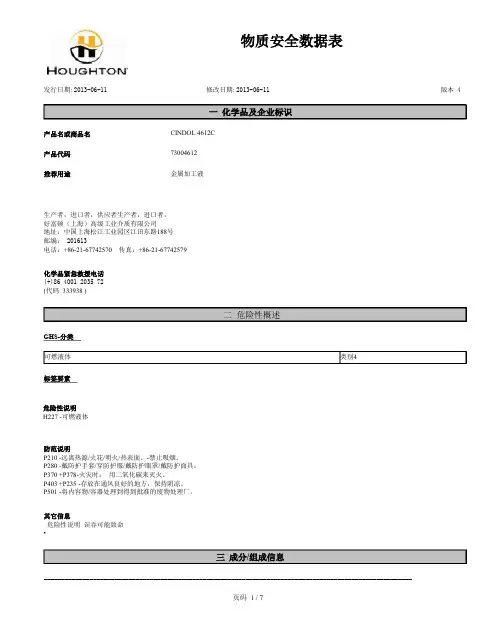
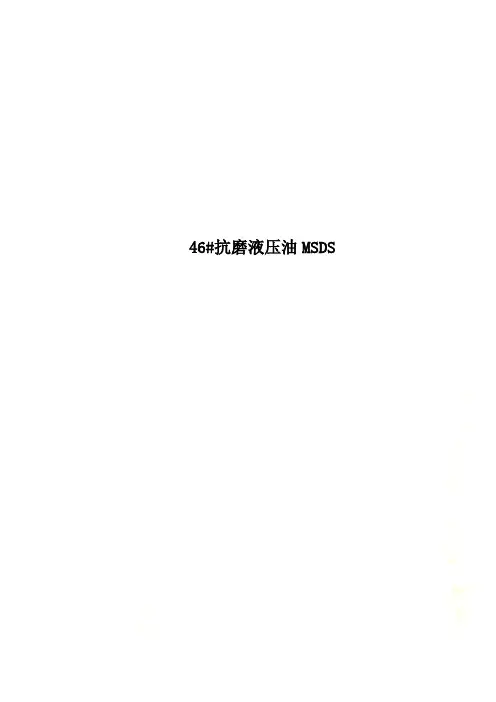
46#抗磨液压油MSDS
MSDS 1.化学品名称
2.危险性概述
3.成分/组成信息
配方组份
4.急救措施
5.消防措施
使所有非急救人员撤离火区。
6.泄漏应急处理
避免接触溢出或释放出来的材料。
关于个人防护设备的选择指南,参见此说明书第8项。
关于处置信息,请参阅第13项。
7.操作处置与储存
9.理化特性
10.稳定性和反应性
11.毒理学信息
额外信息:
用过的油包含在使用过程中累积的有害杂质。
此等有害杂质的浓度视乎用途而定,处理时可能存在损害健康及环境的风险。
所有用过的油应小心处理,并尽可能避免接触皮肤。
在动物试验中,持续接触用过的发动机油会导致皮肤癌。
12.生态学信息
13.废弃处置
14.运输信息
15.法规信息
有关的管制信息并不完整,尚有其它条例适用于本品。
![46#抗磨液压油MSDS[新版]](https://uimg.taocdn.com/0ffcc90bd4d8d15abf234e8c.webp)
46#抗磨液压油MSDS[新版]MSDS1.化学品名称化学品名称 46#抗磨液压油中文名液压油英文名分子式相对分子量CAS号危险性类别2.危险性概述中国分类 GB13690 准则之下未被划分健康危害在正常使用条件下无特定的危险。
过久或重复暴露可引起皮炎。
使用过的油可能含有害杂质。
症状及征像在正常使用情况下,预计不会引起严重影响。
安全危害未被评为可燃物,但会燃烧。
环境危害没有划分为危害环境类。
3.成分,组成信息配方组份配方说明是高度提炼的矿物油和添加剂组成混合物。
根据IP346,这一高精炼的矿物油含有<3%(w/w)DMSO萃取物。
4.急救措施一般信息在正常条件下使用不应会成为健康危险源。
吸入晕眩或反胃不太可能出现,如果发生了,将患者移到有新鲜空气的地方。
若症状持续则要求求助医生。
接触皮肤脱去污染衣物。
用水冲洗暴露的部位,并用肥皂进行清洗。
如刺激持续,请求医。
在使用高压设备时,有可能造成本品注入皮下,如发生此种情况,请立即送往医院治疗,不要等待,以免症状恶化。
接触眼睛用大量的水冲洗眼睛。
如刺激持续,求医。
吞食不要催吐,用水漱口并就医。
医生须知对症治疗。
吸入肺中可导致化学性肺炎。
长期或反复暴露可能造成皮炎。
高压注入伤害需要立即进行外科处理和/或类固醇类治疗,以降低组织伤害和机能丧失。
5.消防措施使所有非急救人员撤离火区。
特定的危险燃烧可能形成在空气中的固体和液体微粒及气体的复杂的混合物,包括一氧化碳,氧化硫及未能识别的有机及无机的化合物。
适当的灭火介质泡沫及干化学粉末、二氧化碳;沙或泥土仅宜用于小规模火灾。
不适用的灭火物切勿喷水。
考虑到环境原因,应该避免卤化物灭火器。
消防人员保护设备合适的保护装置包括在密封空间内接近起火点时必需配戴的呼吸装置。
有害燃烧产物不适用。
6.泄漏应急处理避免接触溢出或释放出来的材料。
关于个人防护设备的选择指南,参见此说明书第8项。
关于处置信息,请参阅第13项。
保护措施避免沾及皮肤及眼睛。
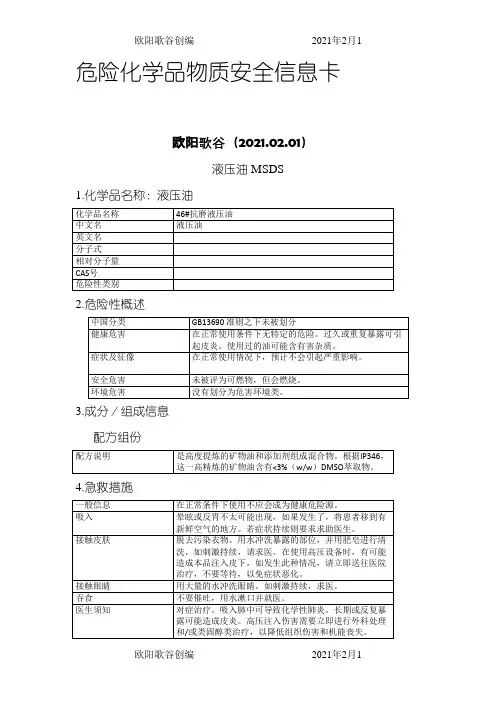
危险化学品物质安全信息卡
欧阳歌谷(2021.02.01)
液压油MSDS
1.化学品名称:液压油
2.危险性概述
3.成分/组成信息
配方组份
4.急救措施
5.消防措施
使所有非急救人员撤离火区。
6.泄漏应急处理
避免接触溢出或释放出来的材料。
关于个人防护设备的选择指南,参见此说明书第8项。
关于处置信息,请参阅第13项。
7.操作处置与储存
8.接触控制和个体防护
9.理化特性
10.稳定性和反应性
11.毒理学信息
额外信息:
用过的油包含在使用过程中累积的有害杂质。
此等有害杂质的浓度视乎用途而定,处理时可能存在损害健康及环境的风险。
所有用过的油应小心处理,并尽可能避免接触皮肤。
在动物试验中,持续接触用过的发动机油会导致皮肤癌。
12.生态学信息
13.废弃处置
14.运输信息
15.法规信息
有关的管制信息并不完整,尚有其它条例适用于本品。
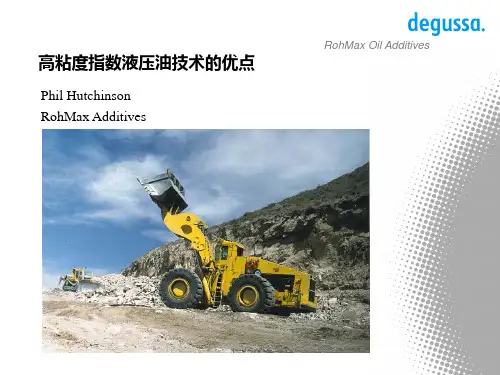
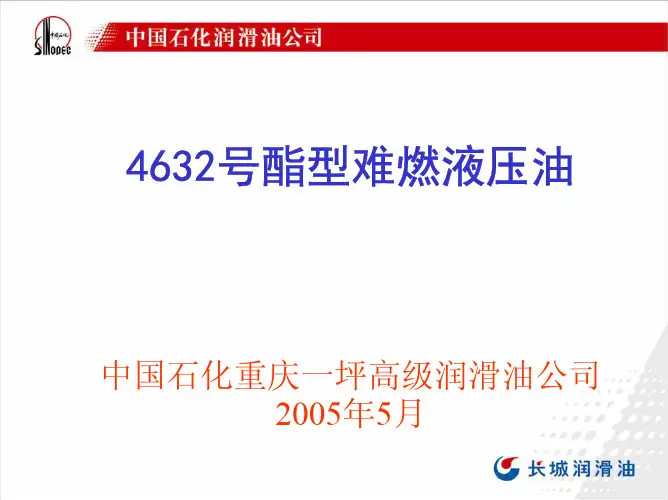

【好富顿金属加工液】液压油美国好富顿产品大全水溶性切削液Houghton Ensis DW655好富顿万安2425 S-14好富顿万安2425 S-8好富顿凯利601M-12HOCUT B50S通用型半合成切削液好富顿切削液,好富顿切削液金属轧制油金属轧制油金属轧制油金属清洗剂金属清洗剂金属防锈剂HOUGHTON ENSIS DW 6062HOUGHTON ENSIS DW 1262金属防锈剂金属成型润滑剂金属成型润滑剂 Metal Forming Lubricants好富顿Houghto热处理淬火系列Houghto Mar-Temp 365 Houghto-Quench K2000 Houghto-Quench GHoughto-Quench G1050 Houghto Quench G2000 Houghto-Quench SHoughto Quench V2000 Houghto Quench BRT Houghto Mar Temp 355 Houghto-Quench K1050 Houghto Mar Temp 2565 Aqua Quench 140Aqua-Quench Inhibitor 312 Aqua-Quench Inhibitor 211 Aqua-Quench 3699Aqua-Quench 371Aqua-Quench 365Aqua Quench 364Aqua Quench 251Aqua Quench 145Houghto Mar Temp 755好富顿Houghto金属切削液好富顿金属加工液Dascool 3090半合成切削液Hocut 795B乳化型切削液Hocut 787H乳化型切削液Hocut B80乳化型切削液Dasco Sol 300EP乳化型切削液Houghto Dromus BL壮马士BL乳化型切削液Hocut 795MP半合成切削液Hocut 1050半合成切削液Hocut B57半合成切削液Hocut B57半合成切削液Hocut 795Dascool 2357EP半合成切削液Dascool 2010US半合成切削液Adrana D 208.08安卓耐半合成切削液Sitala D 201.08斯特莱半合成切削液Sitala CD 400.08斯特莱半合成切削液Hocut FL8-56HRT合成切削液Hocut 760合成切削液Dasco clear 519DF合成切削液Dasco clear 3246合成切削液Dasco clear NOBALT合成切削液Metalina D 202麦利达合成切削液Hocut B50S半合成切削液好富顿Houghto金属切削油Dascolene 110非活性切削油CutMax 226AN活性切削油CutMax T400活性切削油Dascolene598 DBR活性切削油Dascolene598 DBR活性切削油Garia 404 M-10凯利性切削油凯利Garia 405 M-22/32活性切削油Garia 601 M- 12/22凯利活性切削油Garia SL 680凯利活性切削油CutMax SH10C非活性切削油Frapol LT12E活性切削油Dascolene 122非活性切削油Paraol 250派诺非活性切削油Excelene 416非活性切削油Excelene 885A非活性切削油Macron 205 M-5万安非活性切削油Macron 400 M 22/32万安非活性切削油Macron 2425S-8/14万安非活性切削油Macron 2429S-8万安非活性切削油Macron 630S-9万安非活性切削油Macron 630S-9万安非活性切削油Macron C4万安非活性切削油Macron EDM 110/130万安非活性切削油Dascolene 315非活性切削油好富顿Houghto抗燃液压液COSMOLUBRIC HF122抗燃液压液COSMOLUBRIC B-230抗燃液压液COSMOLUBRIC HF130 抗燃液压液COSMOLUBRIC HF122 抗燃液压液HOUGHTO-SAFE 1146XC抗燃液压液HOUGHTO-SAFE 1120抗燃液压液HOUGHTO-SAFE 1120抗燃液压液HYDROLUBRIC 120 B抗燃液压液HOUGHTO-SAFE 520抗燃液压液HOUGHTO-SAFE 620N 抗燃液压液Houghto-Safe 620抗燃液压液HOUGHTO-SAFE 620N抗燃液压液HOUGHTO-SAFE 620抗燃液压液好富顿Houghto金属成型润滑剂DIE-KOTE 7290镁合金脱模剂DIE-KOTE 7275 AM铝合金脱模Drawsol WM 4740冲压(拉伸)成型液Drawsol WM 2800冲压(拉伸)成型液Drawsol WM 2200冲压(拉伸)成型液Houghto-Draw 7079冲压(拉伸)成型油Houghto-Draw 7002冲压(拉伸)成型油Drawsol 165 M冲压(拉伸)成型油Drawsol 741-G冲压(拉伸)成型油Drawsol 850冲压(拉伸)成型油SH0 500金属成型润滑剂Proformer K18B冲压(拉伸)成型油Cindol 3411S冲压(拉伸)成型油好富顿Houghto钢厂工艺用油Metalina D202/HOCUT 767磨辊液Rolshield HM 650/Rolshield HM 340热轧油Rolkleen 300热轧油Rollub 9400/Rolkleen EP 2600乳化型钢冷轧油Rollub 9800/Rollub 502乳化型钢冷轧油Rolkleen AS 2200/Rolkleen AS 2800弥散型钢冷轧... Rolkleen AS 2000弥散型钢冷轧油Fenella CSS 200纯油轧制油Fenella CSS 200LV纯油轧制油Fenella SRH 105/Fenella SRH 87热轧油TEMPERSHIELD 6800/TEMPERSHIELD 6900平整液Fenella Fluid TE 800扩径油Ensis RPO 1200防锈油Steelshield 6299 防锈油Ensis PL1608防锈油MACRON EDM 110电火花油MACRON EDM 130电火花油Polishing Oil CPLPolishing Oil CGL板带修磨油Polishing Oil D板带修磨油MWR Additive EP200纯油轧制油好富顿Houghto有色金属轧制油Tandemol C43 铜轧制油Rollub 1231铜精轧机油Cindol CR/Rollub 514有色金属轧制油Tandemol 93/Tandemol 6700有色金属轧制油Tandemol 6200/Tandemol 6800有色金属轧制油Tandemol 6600/Tandemol 6300有色金属轧制油好富顿Houghto 拉丝润滑油Cindol4625C/Cindol 4625CCINDOL 4683/CINDOL 4625T铝线拉丝油Houghto-Draw WD2800铜线拉丝油Houghto-Draw WD5600铜线拉丝油Houghto-Draw WD201铜线拉丝油Houghto-Draw铜线拉丝油Houghto-Draw WD4100铜钱拉丝油好富顿Houghto 清洗剂Houghto-Clean 221/Cerfa-Kleen 5411 Cerfa-Kleen 5391/Cerfa-Kleen 5502 Houghto Clean HD 50Cerfa-Kleen 5380B/Cerfa-Kleen 5395 Cerfa-Kleen 5378/Cerfa-Kleen 5398好富顿Houghto 防锈剂Ensis PL 1608/安施之PL 1608Ensis PL 1608-10/安施之PL 1608-10Ensis Engine 30/安施之Engine 30Ensis RPO 1200-10/安施之 RPO 1200-10Ensis RPO 1200/安施之RPO 1200Ensis DWG 2462安施之DWG2462Ensis DW 1262/安施之DW 1262Ensis DWO 962安施之DWO 962Dasco Guard DW 4000/Ensis DW 062安施之DW062 Rust Veto 377HF/Rust Veto 4222SRust Veto 4214HF/Rust Veto 4240LFHoughto好富顿金属加工液产品总...好富顿金属加工液产品总汇。
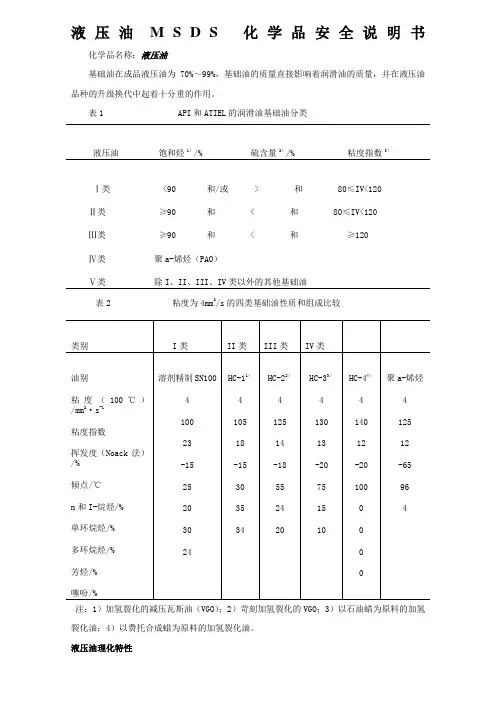
液压油M S D S化学品安全说明书化学品名称:液压油基础油在成品液压油为70%~99%,基础油的质量直接影响着润滑油的质量,并在液压油品种的升级换代中起着十分重的作用。
表1 API和ATIEL的润滑油基础油分类液压油饱和烃1)/% 硫含量2)/% 粘度指数3)Ⅰ类 <90 和/或 > 和 80≤IV<120Ⅱ类≥90 和 < 和 80≤IV<120Ⅲ类≥90 和 < 和≥120Ⅳ类聚a-烯烃(PAO)Ⅴ类除I、II、III、IV类以外的其他基础油表2 粘度为4mm2/s的四类基础油性质和组成比较注:1)加氢裂化的减压瓦斯油(VGO);2)苛刻加氢裂化的VGO;3)以石油蜡为原料的加氢裂化油;4)以费托合成蜡为原料的加氢裂化油。
液压油理化特性易燃易爆性:可燃毒性:有毒LD50:无资料 LC50:无资料危险特性:遇明火、高热可燃。
健康危害:急性吸入,可出现乏力、头晕、头痛、恶心,严重者可引起油脂性肺炎。
慢接触者,暴露部位可发生油性痤疮和接触性皮炎。
可引起神经衰弱综合征,呼吸道和眼刺激症状及慢性油脂性肺炎。
有资料报道,接触石油润滑油类的工人,有致癌的病例报告。
侵入途径:吸入、食入。
个体防护:呼吸系统防护:空气中浓度超标时,必须佩戴自吸过滤式防毒面具(半面罩)。
紧急事态抢救或撤离时,应该佩戴空气呼吸器。
眼睛防护: 戴化学安全防护眼镜。
身体防护: 穿防毒物渗透工作服。
手防护: 戴橡胶耐油手套。
操作处理方法:密闭操作,注意通风。
操作人员必须经过专门培训,严格遵守操作规程。
建议操作人员佩戴自吸过滤式防毒面具(半面罩),戴化学安全防护眼镜,穿防毒物渗透工作服,戴橡胶耐油手套。
远离火种、热源,工作场所严禁吸烟。
使用防爆型的通风系统和设备。
防止蒸气泄漏到工作场所空气中。
避免与氧化剂接触。
搬运时要轻装轻卸,防止包装及容器损坏。
配备相应品种和数量的消防器材及泄漏应急处理设备。
倒空的容器可能残留有害物。
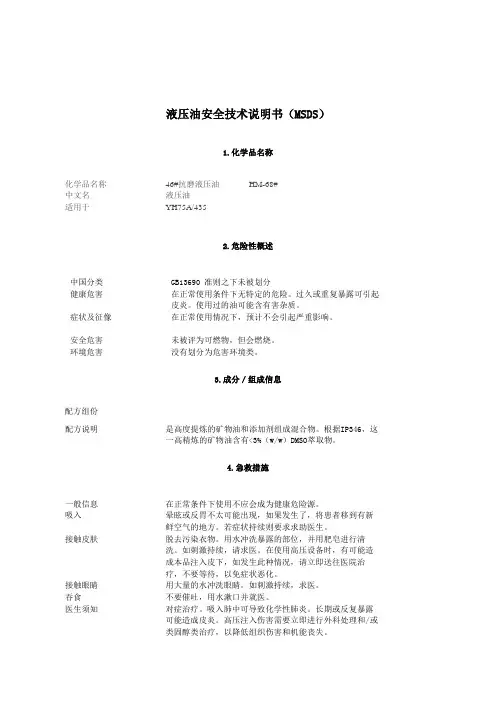
液压油安全技术说明书(MSDS)1.化学品名称化学品名称46#抗磨液压油HM-68#中文名液压油适用于YH75A/4352.危险性概述中国分类GB13690 准则之下未被划分健康危害在正常使用条件下无特定的危险。
过久或重复暴露可引起皮炎。
使用过的油可能含有害杂质。
症状及征像在正常使用情况下,预计不会引起严重影响。
安全危害未被评为可燃物,但会燃烧。
环境危害没有划分为危害环境类。
3.成分/组成信息配方组份配方说明是高度提炼的矿物油和添加剂组成混合物。
根据IP346,这一高精炼的矿物油含有<3%(w/w)DMSO萃取物。
4.急救措施一般信息在正常条件下使用不应会成为健康危险源。
吸入晕眩或反胃不太可能出现,如果发生了,将患者移到有新鲜空气的地方。
若症状持续则要求求助医生。
接触皮肤脱去污染衣物。
用水冲洗暴露的部位,并用肥皂进行清洗。
如刺激持续,请求医。
在使用高压设备时,有可能造成本品注入皮下,如发生此种情况,请立即送往医院治疗,不要等待,以免症状恶化。
接触眼睛用大量的水冲洗眼睛。
如刺激持续,求医。
吞食不要催吐,用水漱口并就医。
医生须知对症治疗。
吸入肺中可导致化学性肺炎。
长期或反复暴露可能造成皮炎。
高压注入伤害需要立即进行外科处理和/或类固醇类治疗,以降低组织伤害和机能丧失。
5.消防措施使所有非急救人员撤离火区。
特定的危险燃烧可能形成在空气中的固体和液体微粒及气体的复杂的混合物,包括一氧化碳,氧化硫及未能识别的有机及无机的化合物。
适当的灭火介质泡沫及干化学粉末、二氧化碳;沙或泥土仅宜用于小规模火灾。
不适用的灭火物切勿喷水。
考虑到环境原因,应该避免卤化物灭火器。
消防人员保护设备合适的保护装置包括在密封空间内接近起火点时必需配戴的呼吸装置。
有害燃烧产物不适用。
6.泄漏应急处理避免接触溢出或释放出来的材料。
关于个人防护设备的选择指南,参见此说明书第8项。
关于处置信息,请参阅第13项。
保护措施避免沾及皮肤及眼睛。
液压油安全技术说明书(MSDS)欧阳光明(2021.03.07)1.化学品名称化学品名称46#抗磨液压油 HM68#中文名液压油适用于YH75A/4352.危险性概述中国分类GB13690 准则之下未被划分健康危害在正常使用条件下无特定的危险。
过久或重复暴露可引起皮炎。
使用过的油可能含有害杂质。
症状及征像在正常使用情况下,预计不会引起严重影响。
安全危害未被评为可燃物,但会燃烧。
环境危害没有划分为危害环境类。
3.成分/组成信息配方组份配方说明是高度提炼的矿物油和添加剂组成混合物。
根据IP346,这一高精炼的矿物油含有<3%(w/w)DMSO萃取物。
4.急救措施一般信息在正常条件下使用不应会成为健康危险源。
吸入晕眩或反胃不太可能出现,如果发生了,将患者移到有新鲜空气的地方。
若症状持续则要求求助医生。
接触皮肤脱去污染衣物。
用水冲洗暴露的部位,并用肥皂进行清洗。
如刺激持续,请求医。
在使用高压设备时,有可能造成本品注入皮下,如发生此种情况,请立即送往医院治疗,不要等待,以免症状恶化。
接触眼睛用大量的水冲洗眼睛。
如刺激持续,求医。
吞食不要催吐,用水漱口并就医。
医生须知对症治疗。
吸入肺中可导致化学性肺炎。
长期或反复暴露可能造成皮炎。
高压注入伤害需要立即进行外科处理和/或类固醇类治疗,以降低组织伤害和机能丧失。
5.消防措施使所有非急救人员撤离火区。
特定的危险燃烧可能形成在空气中的固体和液体微粒及气体的复杂的混合物,包括一氧化碳,氧化硫及未能识别的有机及无机的化合物。
适当的灭火介质泡沫及干化学粉末、二氧化碳;沙或泥土仅宜用于小规模火灾。
不适用的灭火物切勿喷水。
考虑到环境原因,应该避免卤化物灭火器。
消防人员保护设备合适的保护装置包括在密封空间内接近起火点时必需配戴的呼吸装置。
有害燃烧产物不适用。
6.泄漏应急处理避免接触溢出或释放出来的材料。
关于个人防护设备的选择指南,参见此说明书第8项。
关于处置信息,请参阅第13项。
【化学品安全技术说明书-MSDS】1) 有关化学品和公司方面的信息品名4631水-乙二醇抗燃液压液一般特征红色水溶性透明液体4631水-乙二醇抗燃液压液适用于钢铁、煤矿、治金、化工、机械加工等高温、明火附近用途或需要防火的液压系统制造商中国石油化工股份有限公司润滑油分公司服务电话800-810-9886 供应商中国石油化工股份有限公司润滑油分公司服务热线400-810-9886 网址制作日期2011-07-012) 构成成分的名称及含有量化学物质名组成成分含量,wt%水37~43基础液聚醚53~59添加剂混合物4~53) 危险及有害性通常情况下本产品不会危害健康,过度接触可能会对眼睛、皮肤、呼吸等产生刺激性,危险·有害性信息食入对身体有害4) 应急措施的要领进入眼睛时用洁净流水清洗15分钟以上,必要时就医接触皮肤时把沾染的部位擦拭干净后用肥皂清洗,必要时就医吸入时脱离接触区域,吸入新鲜的空气,必要时就医食入时给服2杯水,催吐;如已昏迷,不要进行催吐或喂服任何东西;立即接受医生诊疗医生的注意事项根据病人症状进行治疗5) 发生爆炸火灾时的应对方法灭火剂二氧化碳、干粉、泡沫、清水灭火器等灭火方法喷洒燃烧时发生的有害物质因不完全燃烧产生烟、雾、一氧化碳、醛类等物质6) 发生漏油时的应对方法保护措施发生泄漏时,在清除泄漏的油液时,采用防护器材来保护人体大量泄漏时,用真空泵抽到容器中。
少量可用粘土、沙子等吸附。
收集物装入密封容泄漏处理器,适宜处理7) 使用及储存方法禁止储存在敞口容器中。
在阴凉、干燥、通风好的地方保存,禁止与火苗,火花,高温储存管理物体的接触空容器处理空容器可能还残留部分产品,勿切割、焊接,勿暴露在高温、火焰中等8) 防止泄漏及个人防护器管理方法尽量存放在室内阴凉干燥通风处,使用后确认封口密封,防止油液泄漏对呼吸道的防护高浓度区域请使用防毒口罩对眼睛防护请使用保护眼镜对手的防护请使用耐油性,耐化学性的防护手套对身体保护请使用非渗透性的安全服装及安全鞋卫生注意事项作业后用肥皂清洗,擦拭护肤霜来保护皮肤9) 物理化学特性外观:红色透明液体气味:无异味水含量,wt%:39.5 歧管着火试验:通过闪点:无芯式燃烧持久性:通过10) 安全性及反应性稳定性稳定(室温)保管要求远离强氧化剂、高温、火源等有害分解物质周围环境温度下不会分解聚合反应不发生11) 有关毒性方面的信息毒害信息4631水-乙二醇抗燃液压液中含有乙二醇或二乙二醇,具有一定毒性,食入可中毒,轻者可引起反胃、呕吐或麻醉等不适,重者引起肝、肾等功能异常。
液压油一、液压油的分类与命名液压油的分类方法过去主要有以下几种:按用途分类:航空液压油、舰船液压油、数控机床液压油,特种液压油等。
按使用温度范围分类:普通、高温、低温液压油,宽温范围液压油。
按组成分类:无添加剂型、防锈抗氧型、抗磨型、高粘度指数液压油型等。
按使用特性分类:易燃、难燃、环保型等。
按使用压力分类:普通、高压液压油等。
按添加剂类型分类:无灰、有灰,锌型、无锌、低锌、高锌液压油等。
1982年国际标准化组织ISO发布了液压系统分类标准ISO 6743.4-82,1987年我国等效采用ISO标准制定了润滑剂和有关产品(L类)的分类——第2部分H组(液压系统)的分类标准GB 7631.2-87,1999年ISO出台了新的液压油分类标准ISO 6743.4-1999,与1982年版本相比增加了四种环保型液压液,删除了两种对环境有害的难燃液压油。
开发生物降解型液压油,保护环境,是顺应社会发展的需要。
我国目前正等效ISO 6743.4-1999对原标准GB 76312-87进行修订。
增加环境可接受的液压液HETG、HEPG、HEES、HEPR四种,取消对身体有害的难燃压液HFDS和HFDT两种。
新的液压油分类标准见下表。
液压液的分类GB/T 7631.2—87注:1) 每个品种的基础液的最小含量应不少70%;2)这类液体也可以满足HE品种规定的生物降解性和毒性要求。
根据其应用场合分为流体静压系统用油和流体动力系统用油,流体静压系统用油包括四部分:矿油型和合成烃型液压油(HH、HL、HM、HR、HV、HS);环境可接受的液压液(HETG、HEPC、HEES、HEPR);液压导轨系统用油(HG);难燃液压液(HFAE、HFAS、HFB、HFC、HFDR、HFDU)共十七个品种。
流体动力系统用油包括自动传动液(HA)和联轴节和转换器(HN)两部分共两个品种。
目前,在GB 11118.1-94矿物油型和合成烃型液压油产品标准中对液压油产品名称进行了统一的规范化的标记,标记示例:液压油L-HM46(优等品),其中“L”表示润滑剂类别,“HM”表示抗磨液压油,“46”表示粘度等级(按GB 3141-82规定),“优等品”表示产品质量符合GB 11118.1中所规定的质量等级的档次。
Enersyn SF-C 14 & 15新一代防火液压液简介Enersyn SF-C 14 和 SF-C 15 是防火、水 / 乙二醇基 [HF-C] 液压液。
建议在那些有燃火危险的工业液压系统中,用来代替矿物油液[例如,压铸机,液压轧制和锻造机,开采工业中的机械和驱动系统,以及遥控焊接设备]。
Enersyn SF-C 15 主要用于冶金工业,其优良的润滑特性对重负荷运作极为有利 [例如,压铸和连续铸造]。
典型的含水量为36 %。
Enersyn SF-C 14 主要推荐用于为安全而需要较高含水量的煤矿开采,其典型含水量为 43%。
典型特征Enersyn SF-C 抗燃液压液的典型特性技术特性Enersyn SF-C 15 和 Enersyn SF-C 14 是高性能的水 / 乙二醇液,抗磨性能好。
两者都达到了 Seventh Luxembourg Report 的所有技术和燃烧性的指标。
Enersyn SF-C 14 还通过了毒性方面的要求,获得了用于煤矿开采的 LOB 合格证。
TUV 是上表中 Enersyn SF-C 14 大多数数据的来源。
两种液体都获得了工厂的认可。
除了维氏离心泵试验标准,这些产品还在泵和设备生产厂家的合作下,于各种泵中进行了试验。
这些试验是设计来模拟真实工况的。
例如,Rexroth Hydromatik 轴向活塞泵,大型维氏离心泵,和德国 ORSTA 齿轮泵。
在所有情况下,Enersyn SF-C 抗燃液压液都表现了杰出的性能。
泵试验程序Rexroth Hydromatik A2V5S LD 轴向活塞泵Rexroth Hydromatik 轴向活塞泵 (弯轴设计) 是在连续压铸设备与该泵联用的设计中,用 Enersyn SF-C 15 进行破坏性试验的。
在下表中,可见其完整的试验程序。
设备生产厂家希望泵使用 HF-C 液体、于 120-150 bar 下运行,能够有至少 4000 小时的轴承寿命。